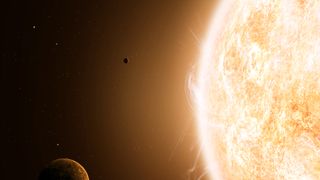Space news, features and articles
Explore Space
Editor's Picks
Latest about Space

Parisian photographer produces phenomenal, perfectly-proportioned 'planetary parade' portrait
By Harry Baker published
A French astrophotographer recently snapped shots of the moon, Venus, Mars, Jupiter, Saturn, Uranus and Neptune in a single evening, and rearranged them to create a striking composite image. Each "planetary parade" member was captured with the same magnification, meaning they are perfectly scaled.

A strange triangle will appear in the zodiac this month. How to see rare 'zodiacal light,' before it disappears.
By Jamie Carter published
A 'false dusk' will be visible during twilight in February, but only from locations that are free of light pollution. Here's everything you need to know about zodiacal light.

Earth grew an extra, never-before-seen 'radiation belt' after last year's supercharged solar storm — and it's probably still there
By Harry Baker published
Data collected from a once-defunct NASA satellite show that Earth grew two extra radiation belts following a supercharged geomagnetic storm in May 2024, including a never-before-seen structure that is "likely still there today," researchers say.

Sun quiz: How well do you know our home star?
By Harry Baker published
Test your knowledge on the giant ball of burning gas at the heart of the solar system.

Venus, the 'love planet', will look extra special this Valentine's Day. Here's why.
By Jamie Carter published
In a cosmic coincidence, Venus — the planet named for the Roman goddess of love — will be at its brightest and best on Valentine's Day. Heres where and when to see it.

In emergency decision, James Webb telescope will study 'city-killer' asteroid 2024 YR4 before its close approach to Earth
By Brandon Specktor published
In a rare "time-critical" decision, the James Webb Space Telescope will study the true size of the "potentially hazardous" asteroid 2024 YR4 twice over the next few months. The asteroid has a roughly 2.3% chance of impacting Earth in 2032.

Watch potential 'city-killer' asteroid 2024 YR4 as it hurtles through space
By Patrick Pester published
Asteroid 2024 YR4 has a tiny chance of hitting Earth in 2032, but for now, you can watch it fly harmlessly through space in a short time-lapse video captured by the NASA-funded ATLAS telescope.

Astronomers catch black holes 'cooking' their own meals in bizarre, endless feeding cycle
By Sharmila Kuthunur published
Black holes can actively regulate the material they consume, using powerful jets of gas blasted into space, according to a new study. It suggests many such cosmic beasts effectively "cook" their own meals.
Sign up for the Live Science daily newsletter now
Get the world’s most fascinating discoveries delivered straight to your inbox.





